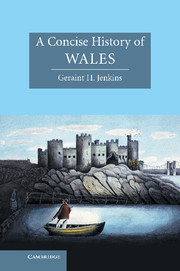Book contents
- Frontmatter
- Contents
- List of illustrations
- Preface
- 1 The earliest inhabitants
- 2 The Heroic Age, 383–1063
- 3 The Anglo-Norman conquerors, c. 1063–1282
- 4 Pestilence, rebellion and renewal, c. 1283–1536
- 5 Early modern Wales, 1536–1776
- 6 A crucible of the modern world, 1776–1900
- 7 Wales awakening? 1901–2006
- 8 Whither Wales?
- Sources of quotations
- Guide to further reading
- Index
- CAMBRIDGE CONCISE HISTORIES
2 - The Heroic Age, 383–1063
Published online by Cambridge University Press: 05 June 2014
- Frontmatter
- Contents
- List of illustrations
- Preface
- 1 The earliest inhabitants
- 2 The Heroic Age, 383–1063
- 3 The Anglo-Norman conquerors, c. 1063–1282
- 4 Pestilence, rebellion and renewal, c. 1283–1536
- 5 Early modern Wales, 1536–1776
- 6 A crucible of the modern world, 1776–1900
- 7 Wales awakening? 1901–2006
- 8 Whither Wales?
- Sources of quotations
- Guide to further reading
- Index
- CAMBRIDGE CONCISE HISTORIES
Summary
From time to time, slipshod historians do the history of Wales a disservice by clinging to outdated or inappropriate labels. Perhaps the most deeply entrenched concept in the interpretation of the period from the withdrawal of Rome to the coming of the Normans is the depiction ‘Dark Age Wales’. When this epithet was first used, it was meant to be a commentary on the relative dearth of historical data rather than a pejorative statement. Scholars to this day are painfully aware that this is one of the most obscure and complicated periods in Welsh annals. So much of the historical record, to quote an eleventh-century Welsh commentator, has been lost as a result of ‘the constant devourings of moths and the yearly borings of ages through times and seasons’ and, in spite of the valiant efforts of scholars, who acquire gainful employment and a sense of worth from subjecting scattered, barely legible and incomplete sources to meticulous scrutiny and analysis, our knowledge of the period remains disturbingly patchy. In the restricted sense that it is a poorly documented period, this was certainly a ‘dark age’ and it is easy to see why some historians are tempted to quote later evidence to light up the darkness. Even key figures like Cunedda, Arthur and St David are wraiths shrouded in mystery.
- Type
- Chapter
- Information
- A Concise History of Wales , pp. 32 - 62Publisher: Cambridge University PressPrint publication year: 2007

